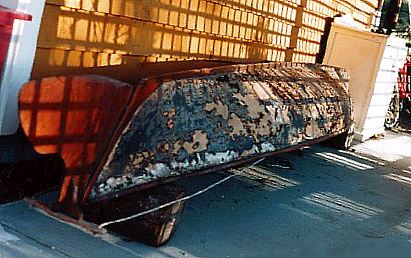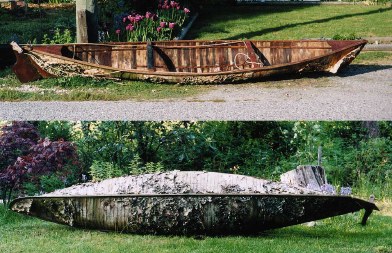An update from Larry Westlake; July 2002
The 12' x 28" canoe "Paper Buoy" built in 1990 made 17-mile open-water crossings of Georgia Strait in 1990, 1991, and 1992. Hull shape design was by Michael McEvoy, but we used a variation of the "Phillips-type" paper/wood construction instead of the lapstreak McEvoy specified. The Phillips brothers used stabilized hide glue, which is difficult to work with and requires special equipment, so we used casein glue, rated by some sources as highly water-resistant.
This boat was made specifically for an environmental fundraising marathon for the "Save the Georgia Strait Alliance", and therefore reused, scrap, and non-toxic materials were used wherever possible. Casein glue was recommended by a few authors, and we used it because it is derived from milk and easy to work with, but we found it is unsuitable.
Casein expands markedly when it absorbs water. When bone-dry it is initially fairly resistant to absorption, and if protected by paint or varnish the boat could be used for about two days without problems. But water penetrates everything, and as soon as a little was absorbed the protective coating crazed and cracked as expansion of the substrate broke up the film. The paint or varnish still appeared to be in good condition, but was a network of microscopic cracks which allowed water to attack the hull. If put in the water with the finish in this condition visible swelling and softening occurred in less than an hour. The relatively hard oil-based varnish coating we used required that the boat be hard-dried and tung-oiled or re-varnished to seal these cracks. Flexible or elastic products such as Hypalon sundeck paint, which is well proven for fabric-covered kayaks, would have been more suitable.
A second problem is that while the glue and paper swell, wood components swell comparatively little. Paper Buoy noticeably decreases in flare as it soaks up, but regains its flare as it dries out again. These stresses wrack the joints in the wooden frame, breaking tight joints and loosening fastenings. Because of the wooden frame, the Paper Buoy returns to the same shape where a monocoque hull might sag or dent, but each cycle does some damage. With stabilised hide glue as used by LiteKraft, this differential swelling was not a problem, apparently because the boats were usually not pampered and so stayed wet, and the shrinkage of hide glue is less than casein.
 A third undesirable characteristic of casein is high alkalinity - it is
caustic, and we were warned not to use brass or bronze fastenings which
would be destroyed very quickly. We used galvanized steel fastenings which
survived, but when Paper Buoy was declared dead, an autopsy revealed total
loss of the zinc coating and some necking where the steel fastenings
penetrated the paper. In the later stages of his senility, Paper Buoy
suffered from powdering and crumbling of the paper as the fiber was
destroyed by the caustic glue. This did not really show up until I had
given up trying to keep the boat alive. In spite of the fact that I worked
very hard to protect and maintain the boat, and always stored it under
shelter, it was only usable for 6 years. Due to the need to dry it out after
use, it could only be used ten or so times a year. (Since it cost $100 or so
to build, and probably another $50 to maintain over the years, that is still
cheaper than renting!) Winter humidity, in years when I could not keep it in
HEATED storage, caused the finish on the paper to flake off and require
complete refinishing. The woodwork, on the other hand, was only ever
refinished once with a light steelwooling and an oil rub, and even in 2000
was still in good shape.
A third undesirable characteristic of casein is high alkalinity - it is
caustic, and we were warned not to use brass or bronze fastenings which
would be destroyed very quickly. We used galvanized steel fastenings which
survived, but when Paper Buoy was declared dead, an autopsy revealed total
loss of the zinc coating and some necking where the steel fastenings
penetrated the paper. In the later stages of his senility, Paper Buoy
suffered from powdering and crumbling of the paper as the fiber was
destroyed by the caustic glue. This did not really show up until I had
given up trying to keep the boat alive. In spite of the fact that I worked
very hard to protect and maintain the boat, and always stored it under
shelter, it was only usable for 6 years. Due to the need to dry it out after
use, it could only be used ten or so times a year. (Since it cost $100 or so
to build, and probably another $50 to maintain over the years, that is still
cheaper than renting!) Winter humidity, in years when I could not keep it in
HEATED storage, caused the finish on the paper to flake off and require
complete refinishing. The woodwork, on the other hand, was only ever
refinished once with a light steelwooling and an oil rub, and even in 2000
was still in good shape.
The photo above shows PB in 1998, when I still had hopes of repair. Other commitments precluded this, and by 2000 it had deteriorated even though under shelter as shown. In 2001 it was put out in the garden to complete its dissolution, and is now being converted to an arbour for clematis.
The second photo-pair shows its condition after a year without shelter. The paper has been turned to crumbling, white-crusted scabs by the alkaline adhesive in the constant presence of moisture. The frame remains intact and strong, but also shows attack by the alkali.
 All of the problems experienced with this boat were apparently because of
the glue chosen. Water-borne or water-based adhesives are desirable because
they allow the paper to conform to the mold shape. Solvent-based adhesives
or resins do not make the paper conformable and complicate construction
considerably. Adhesives must have enough "body" to fill the pores in the
paper and seal the fibres fairly thoroughly. The two companies I know of
who successfully made paper boats used opposite, and apparently equally
effective strategies. Waters & Sons used heat-set shellac (a natural
alcohol/water-borne but waterproof resin) to exclude water for the "Beat Em"
approach, and LiteKraft (Phillips brothers) used hide glue that actually
lasted better if kept outside and moist - the "Join Em" approach. Both
these adhesive processes present problems for the amateur builder (the
Waters burned their shop down twice) but do give good results. I inspected
a 40plus-year-old Litekraft boat that had seen hard use and outside storage
all its life, that was still (barely) usable. Most of the wood was rotten,
but the hull was still tough and leathery, though the surface was tattered
and frayed from wear. There is one LitKraft boat I know of which has been
fully restored and is proudly displayed at traditional boat gatherings.
Waters boats, though much older, exist in a few museum and private
collections.
All of the problems experienced with this boat were apparently because of
the glue chosen. Water-borne or water-based adhesives are desirable because
they allow the paper to conform to the mold shape. Solvent-based adhesives
or resins do not make the paper conformable and complicate construction
considerably. Adhesives must have enough "body" to fill the pores in the
paper and seal the fibres fairly thoroughly. The two companies I know of
who successfully made paper boats used opposite, and apparently equally
effective strategies. Waters & Sons used heat-set shellac (a natural
alcohol/water-borne but waterproof resin) to exclude water for the "Beat Em"
approach, and LiteKraft (Phillips brothers) used hide glue that actually
lasted better if kept outside and moist - the "Join Em" approach. Both
these adhesive processes present problems for the amateur builder (the
Waters burned their shop down twice) but do give good results. I inspected
a 40plus-year-old Litekraft boat that had seen hard use and outside storage
all its life, that was still (barely) usable. Most of the wood was rotten,
but the hull was still tough and leathery, though the surface was tattered
and frayed from wear. There is one LitKraft boat I know of which has been
fully restored and is proudly displayed at traditional boat gatherings.
Waters boats, though much older, exist in a few museum and private
collections.